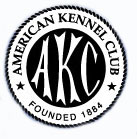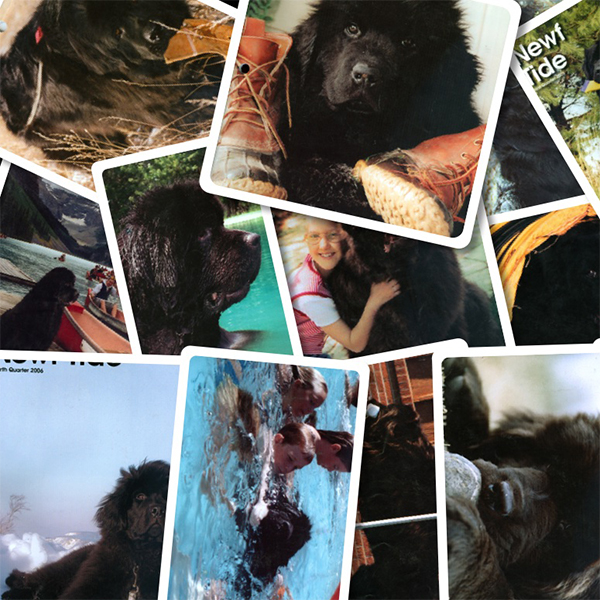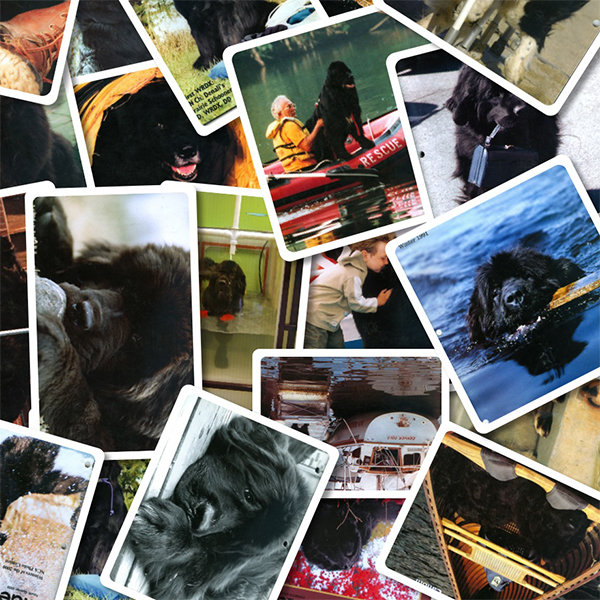
Mary Dewey, the author of this month’s column, has been in Newfoundland dogs literally all her life, as her parents, Kitty and Maynard Drury, started Dryad Kennels before she was born. She entered the world of dog shows early, handling her first Newf at the age of 8 and winning the Junior Showmanship class at the National Specialty in 1955. The Dryad name was signed over to her in 1970 and she has bred many champions. She has served on the Board of the Newfoundland Club of America and she is a founding member of the High Country Newfoundland Club. She is an NCA Breed Mentor.
After a lifetime of living with the Newfoundland, I am writing to express my concerns with the breed as I see it in the show ring. The Newfoundland is a working dog not a beauty contestant.
“The Newfoundland is a sweet-dispositioned dog that acts neither dull or ill-tempered”. That is the very first sentence of the standard. Why is it that we see Newfs in the ring who shy away from the judge, and growl at other dogs and at judges? Why is it that owners make excuses for their dogs rather than face the fact that their Newf has a questionable temperament? There is no excuse for any deviation from the standard on this hallmark of the breed.
The standard also states: “The adult Newfoundland has a flat, water resistant, double coat that tends to fall back into place when rubbed against the nap. The outer coat is coarse, moderately long and full, either straight or with a wave. The undercoat is soft and dense, although it is often less dense during the summer months or in warmer climates. Hair on the face and muzzle is short and fine. The backs of the legs are feathered all the way down. The tail is covered with long dense hair. Excess hair may be trimmed for neatness.”
There is a reason the Newfoundland coat to be so described. How could our dogs survive in the northern Atlantic Ocean with a coat that allows cold water to contact the skin? While our Newfs today are beautifully groomed, I feel they are not groomed with the correct coat in mind. Those who compete is dog shows must never forget that the Newfoundland is a working dog. Look at your dog after a swim. Does he dry off immediately, or is he soaked to the skin? Our dogs today are sculpted to present a “perfect” picture and they do not look like true working dogs. Remember that all the grooming in the world cannot change a bad dog into a good one and that grooming is not reproduced in the whelping box. Look under the coat to see how the dog is really structured.
The head is the hallmark of the breed and what separates the Newfoundland from other breeds. The head style seems to be changing, and I feel we are seeing heads that are overdone. Bitches are often looking decidedly unfeminine.
Regardign the eyes, the standard states that they are “relatively small, deep-set and spaced wide apart” and that “eyelids fit closely with no inversion.” The eyes contribute to the characteristics of an intelligent and dignified dog, as stated in the standard. We should not see eyes that pop out at us or that have visible haw. How many eyes have you seen recently that have really fit the standard? I feel that the color of the eye is nowhere as important as the expression it gives of gentleness.
The standard also notes that “forehead and face are smooth and free of wrinkles.” It seems to me that I am seeing more and more dogs, and bitches, that have a face full of wrinkles. That is not correct. Look at the pictures of the older Newfs and see how the face has changed over the years. Our standard also states that “slope of the stop is moderate but because of the well developed brow, it may appear abrupt in profile.” Run your hands over the dog’s stop. Is that really a moderate slope, or has it become abrupt?
One last comment: Newfs should not toe in. Just because so many do does not make it correct. Watch your dogs. There are correct fronts out there, and we should try to breed to correct this common fault.
The standard is our guide. We must reread it regularly to help us each evaluate our breeding program. We are all struggling in our quest to produce the “perfect” dog and the standard helps us to do so. We must each continually study our own dogs as well as those of others to help us in our quest. It is important also to have basic understanding of the anatomy and physiology of the dog. Go give your Newf a pat on the head, and sit down this evening and read your standard.

